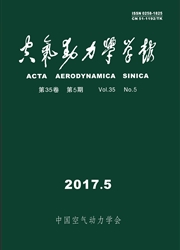

 中文摘要:
中文摘要:
采用格子波尔兹曼方法及浸没边界法,发展了一套适用于自由游动的三维数值研究程序。进而以多尾鳍推进仿生航行器为原型,讨论了尾鳍数目、形状、材料刚度等构型参数及振幅、频率等尾鳍摆动参数对推进性能的影响。结果表明对称布置、反对称摆动的双尾鳍能够明显消除侧向力而避免航行器主体的横向晃动,且推力大于两个单独尾鳍的简单加和;在中等Reynolds数下,具有波动性质的柔性尾鳍不论是推进速度还是推进效率均优于刚性尾鳍;当尾鳍单纯摆动推进时,具有完整鳍面的半椭圆形尾鳍的推进性能优于后部有缺口的深叉形尾鳍。
 英文摘要:
英文摘要:
A numercial code for 3-dimensional fluid flow around swimming bodies were developed .The Immersed Boundary method (IBM)was applied to characterize the moving and deformable fluid-body inter-face in terms of a momentum forcing so that bodies′motion and fluid flow were uncoupled.The fluid flow was solved by Lattice Boltzmann method (LBM)which was well suited to be parallelized and the body mo-tion was devided into beating which was pre-specified and swimming which was calculatied according to the resultant forces and moments.Then,the self-propulsion of a biomimetic unmanned underwater vehicle (UUV)with multiple fins was simulated,and the effects of fins′properties and of beating parameters on the propulsion performance were discussed in detail.It was shown that the lateral force generated by symmetric double fins almost vanished,and the trust was enhanced where the vehicle cruise speed was larger than twice the speed by single fin.UUV propelled by flexible fins swam much faster than that by rigid ones.Under the condition of present work,the optimized wavelength of the flexible fin is about 1.25 times the fin length, and the vehicle swam faster with lager beating amplitude or with higher frequency.The propulsion perform-ance of Semi-oval-shaped caudal fin was better than that of deeply forked tail fin when the vehicle paraded with low speed.
 同期刊论文项目
同期刊论文项目
 同项目期刊论文
同项目期刊论文
 期刊信息
期刊信息
